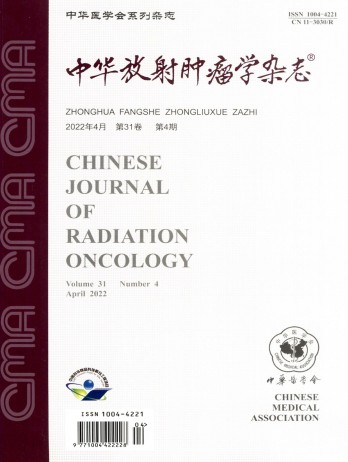Analysis of recurrence pattern of neoadjuvant therapy combined with surgical treatment for esophageal squamous cell carcinoma
引用次数: 0
Abstract
Objective To evaluate the recurrence pattern and identify the risk factors of esophageal squamous cell carcinoma after neoadjuvant therapy combined with surgery. Methods Clinical data of 275 patients with thoracic esophageal squamous cell carcinoma treated with neoadjuvant therapy combined with surgery from December 2011 to December 2015 were retrospectively analyzed. The follow-up data of the enrolled patients were complete and analyzable. The recurrence pattern, recurrence time, recurrence location and influencing factors after neoadjuvant therapy in combination with surgery were analyzed. The recurrence rate was calculated by Kaplan-Meier method. The multivariate analysis was performed by Cox regression model. Results The median follow-up time was 32(3-84) months, and the median time of the first recurrence was 10.6(2.0-69.1) months. The 1-, 2-and 3-year recurrence rates were 32.0%, 45.1% and 52.3%, respectively. A total of 152 cases (55.3%) had recurrence. Among them, 77 cases (50.6%) had local-regional recurrence (LRR), 34 cases (23.4%) had distant metastasis (DM), 33 cases (21.7%) had LRR+ DM and 8 cases (6.0%) had recurrence in unknown site. Among the patients with LRR, lymph node recurrence was the most common (n=98, 89.1%). For DM patients, lung metastasis (n=33, 49.3%), liver metastasis (n=16, 23.9%), bone metastasis (n=14, 20.9%) and non-regional lymph node metastasis (n=14, 20.9%) were commonly observed. The multivariate analysis showed that postoperative T stage (P=0.008), N stage (P<0.001) and the number of lymph node dissection (P<0.001) were the independent risk factors for recurrence after treatment. Conclusions The recurrence rate after neoadjuvant therapy remains relatively high for esophageal squamous cell carcinoma, and the regional lymph node is the most common site of recurrence. Postoperative pathological T staging, N staging and the number of lymph node dissection are the independent risk factors for recurrence after treatment. Key words: Esophageal neoplasm/neoadjuvant treatment; Recurrence pattern; Risk factor食管鳞状细胞癌新辅助治疗联合手术治疗的复发模式分析
目的探讨食管鳞状细胞癌术后新辅助治疗的复发模式及危险因素。方法回顾性分析2011年12月至2015年12月275例胸段食管鳞状细胞癌新辅助治疗联合手术治疗的临床资料。入选患者的随访数据是完整和可分析的。分析新辅助治疗结合手术后的复发模式、复发时间、复发部位及影响因素。复发率采用Kaplan-Meier法计算。采用Cox回归模型进行多元分析。结果中位随访时间为32(3-84)个月,中位首次复发时间为10.6(2.0-69.1)个月。1、2和3年复发率分别为32.0%、45.1%和52.3%。复发152例(55.3%)。其中77例(50.6%)局部复发,34例(23.4%)远处转移,33例(21.7%)LRR+DM,8例(6.0%)不明部位复发。在LRR患者中,淋巴结复发最为常见(n=98,89.1%)。DM患者中,肺转移(n=33,49.3%)、肝转移(n=16,23.9%)、骨转移(n=14,20.9%)和非区域淋巴结转移(n=14,209%)最为常见。多因素分析显示,术后T分期(P=0.008)、N分期(P<0.001)和淋巴结清扫次数(P<0.001。结论食管鳞状细胞癌新辅助治疗后复发率较高,局部淋巴结是最常见的复发部位。术后病理T分期、N分期和淋巴结清扫次数是治疗后复发的独立危险因素。关键词:食管肿瘤/新辅助治疗;复发模式;风险因素
本文章由计算机程序翻译,如有差异,请以英文原文为准。
求助全文
约1分钟内获得全文
求助全文
来源期刊
自引率
0.00%
发文量
6375
期刊介绍:
The Chinese Journal of Radiation Oncology is a national academic journal sponsored by the Chinese Medical Association. It was founded in 1992 and the title was written by Chen Minzhang, the former Minister of Health. Its predecessor was the Chinese Journal of Radiation Oncology, which was founded in 1987. The journal is an authoritative journal in the field of radiation oncology in my country. It focuses on clinical tumor radiotherapy, tumor radiation physics, tumor radiation biology, and thermal therapy. Its main readers are middle and senior clinical doctors and scientific researchers. It is now a monthly journal with a large 16-page format and 80 pages of text. For many years, it has adhered to the principle of combining theory with practice and combining improvement with popularization. It now has columns such as monographs, head and neck tumors (monographs), chest tumors (monographs), abdominal tumors (monographs), physics, technology, biology (monographs), reviews, and investigations and research.

 求助内容:
求助内容: 应助结果提醒方式:
应助结果提醒方式:


